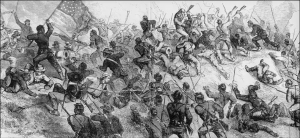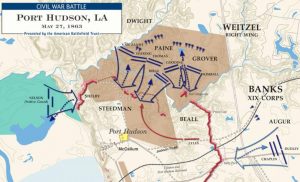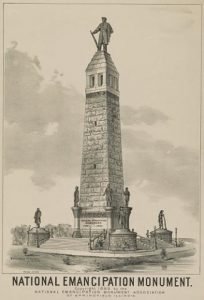“Blackest Man in New Orleans” – Captain Cailloux of the Louisiana Native Guards – Part 2
Find Part One Here
The Native Guards on the extreme right of the Union flank at Port Hudson were positioned in front of some of the roughest terrain on the battlefield and ordered to attack the strongest portion of the fortification defended by Colonel W.B. Shelby’s 39th Mississippi and two supporting batteries. The flood plain in front of them was under water, and they would be exposed to enemy fire on all three sides once they made the charge; Mississippi troops in rifle pits on the high ground to the left, an artillery unit of two eight-inch Columbiads staring down from their right, and the Confederates in the fort to their front. On the morning of March 27, they formed their line of battle in a grove of willow trees just south of Telegraph Road, with support from the 6th Massachusetts Artillery and dismounted cavalry from the 1st Louisiana Union Cavalry. However, once Confederates began bombarding their position, the Union artillery limbered their pieces and abandoned the position, leaving the two black regiments to make the charge unsupported.

At about ten o’clock in the morning, they started forward on the double-quick to cross the six hundred yards of soggy ground between them and the Confederate fortification. They conquered four hundred yards before the torrent of artillery and musket fire was let loose on the Native Guards. The black soldiers fired a single volley before they were forced to fall back under the hailstorm of shot and shell, leaving scores of dead and wounded on the battlefield. Their commander, Brigadier General William Dwight, Jr. – who was supposedly inebriated underneath a tree in the rear – ordered another charge, but his subordinate, Colonel John Nelson, realized that it would be suicidal, and commanded the black troops to take cover in the willow trees and fire from their position to make it appear as if they had commenced the second charge. At the end of the day, out of the less than 1,080 of the black troops who engaged in the charge, their casualties numbered 169 killed or wounded, meaning a casualty percentage of about 15%. The entire Union army suffered over 1,950 casualties in the May 27 charge, while Confederates got off with only several hundred.[1]
One casualty among the Louisiana Native Guards hit the 1st Regiment hard. Company E of the 1st Regiment had been appointed the color company in charge of carrying the regiment’s flag, making them the ideal targets for the Confederates. The men that charged the field could see Captain André Cailloux leading them, waving them forward with his sword in his good arm while the other – struck in the elbow by a ball earlier – hung useless by his side. He was reported to have shouted, “En avant, mes enfants!” (Forward, my children!) and “Follow Me!” as he plunged into the heat of the fight. Cailloux was soon struck down in the storm of shell and bullets, a devastating loss that damaged the morale of the Native Guards. His body lay the closest to the Union lines.[2]

On the evening of May 27, a truce was called to facilitate the removal of dead and wounded from the field, but through some oversight, the white flag was not raised on the sector of the battlefield where the Native Guards had fought, meaning the bodies of the fallen were left to swell and putrefy in the Louisiana summer heat. Any attempt by the surviving Native Guards to retrieve their fallen was met by Confederate sharpshooters. It wasn’t until the Confederates complained about the stench and made a request to Banks for the field to be cleared that the black troops were able to gather their dead unmolested. By then, the black bodies had been rotting in the sun for six weeks. The only way they could identify Cailloux’s remains was by a ring he wore from the Society of Friends of the Order in New Orleans, a mutual aid society to which he served as secretary.
The Federal army continued to siege Port Hudson and another charge was attempted on June 14, though the Native Guards – now called the Corps d’Afrique – were held in reserve.[3] They also volunteered for a special storming party, but Banks refused their assistance for the assignment. Confederate Major General Franklin K. Gardner surrendered Port Hudson on July 9 after news of the fall of Vicksburg, making the siege at Port Hudson the longest continuous siege of the Civil War up to that time.[4]
The Corps d’Afrique went on to fight other battles and campaigns, like the Red River Campaign and the final assault at Fort Blakeley near Mobile. But Port Hudson was forever fixed as the moment they proved themselves capable of combat and worthy of respect amongst their white comrades. Banks wrote after the siege that the black unit “in many respects… was heroic. They require only good officers… and careful discipline to make them excellent soldiers.” Other soldiers from the battle would write, “The negroes fought bravely, and have triumphantly vindicated themselves from the aspersions cast upon their courage.”[5] Some were not convinced, and the actions of the black soldiers at Port Hudson threatened Confederate ideologies, as General Howell Cobb wrote, “If slaves make good soldiers, our whole theory of slavery is wrong.”[6]

The results of the charge at Port Hudson would not be experienced by those who gave their lives during that fateful charge. Captain André Cailloux was one of them. The New York Times had reported on the battle and gave special mention to the “blackest man in New Orleans” when it wrote, “Captain CAILLOUX of the First Louisiana … died the death of a hero, leading on his men in the thickest of the fight.”[7] His funeral took place in New Orleans on July 29, 1863, and was considered impressive and well attended by an integrated crowd, including sick and convalescing soldiers from the Native Guard who turned out to pay their respects. Six black captains from the 2nd Regiment of the Louisiana Native Guards served as pallbearers while the 42nd Massachusetts band played the dirge. The Reverend Claude Paschal Maistre, suspended pastor of St. Rose of Lima Parish and a known abolitionist sympathizer, officiated at the ceremonies in defiance of the archbishop of New Orleans, Jean-Marie Odin. After receiving last rites, his flag-draped casket was conveyed to the hearse by eight black soldiers with two black companies of the 6th Louisiana (colored) Regiment serving as honor guard in the procession down Esplanade Avenue. Cailloux was laid to rest in the St. Louis Cemetery No. 2 on Bienville Street. His widow, Felicie, struggled for several years to receive a widow’s pension for her late husband’s service while working as a domestic servant for Reverend Maistre, the man who officiated André’s funeral. She died in poverty in 1874.[8]

Today, it’s uncertain exactly where in St. Louis Cemetery Cailloux’s grave is located, due to poor recordkeeping. A plaque was installed in 1998 to commemorate the cemetery as the final resting place of many black soldiers who served in the Civil War, giving special mention to Cailloux. He has been considered the first black hero soldier of the Civil War, revered as a martyr and brave captain who led the charge at Port Hudson. At the National Negro Convention that convened in Syracuse in October 1864, Cailloux’s successor as captain of Company E stepped onto the platform carrying the battle flag his company bore at Port Hudson, “stained with the blood of the brave Cailloux.”[9] His name became synonymous with black heroism and was spoken often in black politics throughout the decades. Though efforts to create a National Emancipation Monument were thwarted by lack of funding and race relations following Reconstruction, it was advertised that its “crowning statue will be a bronze representation of Captain André Cailloux and will be thirty feet high.”[10]
The significance of the attempts to immortalize Captain André Cailloux are indicative of the need for the African American population during and after the war to venerate important figures that represented their collective history. Cailloux began life as an enslaved black in Louisiana, bought his freedom, made a respectable life for himself and his family in New Orleans, and served in the military at a rank that many black soldiers were unable to achieve due to politics and racist commanders. He was accepted by the free black community, despite his past as an enslaved man with a darker complexion than the majority of prominent free people of color in New Orleans. Even his funeral became the stuff of legend when a sympathetic white priest was willing to give the eulogy in front of an integrated crowd of black and white spectators who came to honor the hero of Port Hudson. His valor at Port Hudson not only validated his own bravery, but that of all black soldiers, proving the nay-sayers wrong. In a way, he was “living the dream” of both free and enslaved blacks who would go on to advocate for suffrage and equal rights under the law. His life and his death became the model of what blacks were willing to fight and die for, and we don’t even have a picture of him.
Endnotes
[1] James G. Hollandsworth, Jr. The Louisiana Native Guards: The Black Military Experience During the Civil War, (Baton Rouge, Louisiana State University Press, 1995), pp. 53-58
[2] Ibid, p. 54-55, 59; Matthew Hington, “How A Black Civil War Hero’s Funeral Paved The Way For Second Lines,” Very Local: Know Your NOLA, June 25, 2021, https://www.verylocal.com/second-line-funerals/2058/
[3] Hollandsworth, p. 60; The Native Guards were reorganized into the 1st, 2nd, and 3rd Corps d’Afrique, effective June 6, 1863, General Orders No. 47, OR, Vol. XXVI, Part 1, p. 539
[4] The siege of Port Hudson lasted 48 continuous days of fighting. The “Siege” of Petersburg in Virginia cannot be considered a true military siege because supplies were able to flow to the besieged party, though it would have held the record for the longest siege of the war lasting 292 days in 1864.
[5] Banks to Halleck, May 30, 1863, OR, Volume XXVI, Part 1, pp. 44-45; Entry for June 13, 1863, in Lorin L. Dame Diary, May 30, 1863, in Civil War Correspondence, Diaries and Journals, roll 10, MAHS; Boston Daily Evening Transcript, June 6, 1863; Henry T. Johns, Life with the Forty-ninth Massachusetts Volunteers, (Pittsfield, Massachusetts, 1864), pp. 254-255
[6] Daniel P. Smith, Company K, First Alabama Regiment: or, Three Years in the Confederate Service, (N.d., reprint. Gaithersburg, Mo., 1984), p. 63; “How the Yankees Drove the Negroes to Slaughter at Port Hudson,” Charleston Mercury, August 14, 1863; Howell Cobb to James A. Seddon, January 8, 1865, OR, Series IV, Vol. III, p. 1009
[7] “Important from Louisiana,” The New York Times, June 13, 1863
[8] Hollandsworth, p. 69; “André Cailloux and Antebellum New Orleans,” Creolegen, May 27, 2015, http://www.creolegen.org/2015/05/27/andre-cailloux-and-antebellum-new-orleans/;
[9] Stephen Ochs, “The Rock of New Orleans,” The New York Times, July 31, 2013. https://opinionator.blogs.nytimes.com/2013/07/31/the-rock-of-new-orleans/?searchResultPosition=1
[10] Elizabeth Varon, “The Statue That Never Was,” University of Virginia, John L. Nau III Center for Civil War History, July 6, 2020, https://naucenter.as.virginia.edu/statue-never-was; “Liberty Monument,” September 2, 1894, Sacramento Bee
Great post, Sheritta.
Thank you for this post.
Guuuuurl, this piece was so on point and time. Earlier today a friend that founded the USCT page on FB posted an inspiring piece describing Captain Andre’ Cailloux and I had to add my favorite tidbits of his fascinating life. This begat others posting about him and discussions thereof. I began to dig around the inter webs for more about the USCT action @ Port Hudson and the article above appeared in my emails simultaneously…thanks
Thanks for the posts. I would “like” them but for some reason it never allows me.
The standard view of the Native Guards charge is that it was inspiring. I can see that, but it always makes me sad. The attack had no chance and Dwight was a drunken incompetent who owed his position to his Massachusetts connections hence why Banks cultivated him. In addition, Banks was in my opinion the worst major Federal commander of the war. The bodies were not buried (due to Banks) until after Port Hudson surrendered.
The white officers of the Native Guards were a sorry lot (this was too often the case in the USCT as well). Many were stripped of their rank in the months after for various infractions, with one of them torturing his soldiers at Fort St. Philip. The commander of the 3rd Native Guards was arrested for cowardice at Port Hudson when he refused to advance.
These were brave men, and the charge made for good Union propaganda, but they deserved better than Banks, Dwight, and the white officers who saw the Native Guards as a means to collect more pay and gain promotion they might otherwise be denied.
Yep… they got nowhere near the Confederate earthworks. They advanced without their commander, moved a short distance forward in the open, got pummeled with iron and lead while standing in formation, and then retreated. It didn’t last long, but they stood their ground and took it. It was a very one-sided moment. An awful killing.
Under the standards of the time, those men performed superbly. Despite having to conduct a frontal attack with no artillery support – considered near suicidal in that time – they advanced and, as you say, held their ground as long as they could. Then they retreated in good order – the most difficult military maneuver there is – while under enemy fire. That performance is a testament to the quality of their training and first class company leadership. Its tough to command men in combat. You have to enforce standards and discipline, while still maintaining a viable, real relationship with your men. The men *have* to trust their commanders. Clearly, these men did.
Tom
Although not at Port Hudson, the 2nd Louisiana Native Guards served at Fort Massachusetts on Ship Island (MS) and Fort Pike (LA) during the Port Hudson Campaign.
A good source for those interested in the 2nd Louisiana Native Guard is: Daniels, Col. Nathan W. Thank God My Regiment (is) an African One: The Diary of Colonel Nathan W. Daniels. Edited by C.P. Weaver. Baton Rouge, Louisiana and London: Louisiana State University Press, 1995.